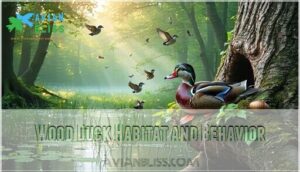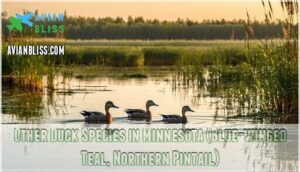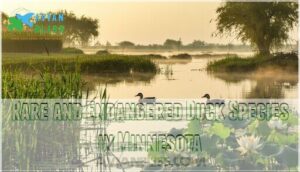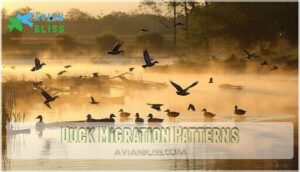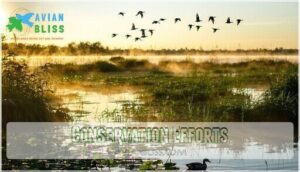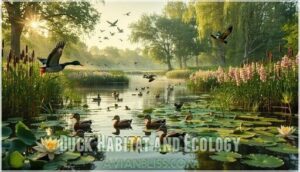This site is supported by our readers. We may earn a commission, at no cost to you, if you purchase through links.
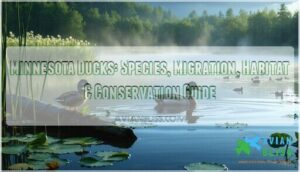
Minnesota’s 20-plus duck species have navigated the state’s wetlands for millennia, but shifting migration windows and habitat loss are rewriting their ancient playbook. From the striking Wood Duck tucking into tree cavities to the endangered American Black Duck clinging to survival, these waterfowl face challenges that demand both scientific understanding and community action.
Your wetlands, hunting traditions, and conservation dollars directly shape whether future generations will hear wings whistling overhead each spring and fall.
Table Of Contents
- Key Takeaways
- Minnesota Duck Species
- Duck Migration Patterns
- Conservation Efforts
- Duck Habitat and Ecology
- Duck Hunting and Management
- Frequently Asked Questions (FAQs)
- What are the cultural impacts of ducks?
- How do ducks influence local traditions?
- What historical events involved Minnesota ducks?
- How do ducks affect local cuisines?
- What are common duck myths and folklore?
- What do Minnesota ducks eat throughout the year?
- How can I identify duck species by sound?
- Do ducks mate for life in Minnesota?
- What diseases affect Minnesota duck populations?
- How do urban areas impact duck behavior?
- Conclusion
Key Takeaways
- Minnesota’s 20+ duck species face major threats from climate change (5°F warmer winters since 1970) and habitat loss, with blue-winged teal crashing 60% in 2025 and American Black Duck populations dropping 50% since 1955.
- Warmer temperatures are rewriting migration patterns—12 major species now overwinter farther north (60+ km shifts), departing later and traveling shorter distances than historical norms.
- Minnesota invests $175 million annually in wetland restoration (targeting 64,000 basins) through strategic habitat work, prescribed burning, and water control structures that deliver both duck populations and ecosystem services like flood mitigation.
- Individual action matters beyond policy—volunteer restoration work, citizen science monitoring, conservation donations, and responsible hunting practices directly determine whether future generations inherit thriving waterfowl populations.
Minnesota Duck Species
Minnesota is home to over 20 duck species, from the familiar mallards you’ll spot on city lakes to the rare visitors that only seasoned birders get to see. You’ll find puddle ducks in shallow marshes and diving ducks in deep waters, each adapted to their own slice of wetland habitat.
Here’s what you need to know about the ducks calling Minnesota home.
Mallard Ducks in Minnesota
If you’ve ever spotted a duck with a gleaming green head paddling through a Minnesota pond, chances are you’ve locked eyes with a Mallard—the state’s most widespread and resilient waterfowl success story. These adaptable ducks thrive everywhere from city parks to remote marshes, making them the backbone of Minnesota’s waterfowl populations.
Mallard behavior shifts with seasons—nesting in spring, feather molting in summer, and forming massive flocking patterns come fall. Their spoon-like beak adaptation lets them filter food from shallow water with surprising efficiency.
Wood Duck Habitat and Behavior
While mallards claim the spotlight, Wood Ducks are Minnesota’s shy forest dwellers—stunning, secretive, and surprisingly comfortable nesting 50 feet up in a hollow tree. Here’s what makes their Duck Behavior fascinating:
- Nesting Habits rely on Tree Cavities near wetlands
- Brood Rearing starts when ducklings leap from nests
- Foraging Behavior targets acorns and aquatic insects
- Water Quality determines Waterfowl survival rates
- Habitat Preservation protects these Duck Habitats
Their powerful claws grip bark effortlessly—essential survival gear.
Other Duck Species in Minnesota (Blue-winged Teal, Northern Pintail)
Beyond the wood duck’s treetop theatrics, you’ll find two other Minnesota standouts—the blue-winged teal with its powder-blue wing patches and the northern pintail, built like a sleek fighter jet with that signature needle-thin tail. These Waterfowl of Minnesota showcase impressive Duck Species Diversity, each adapted to different Pintail Habitat needs.
Unfortunately, blue-winged teal numbers hit a record low in 2025—down 60% from 2024—reflecting troubling Duck Population Trends across Waterfowl Behavior and Teal Migration Patterns that now shift earlier each spring.
- Blue-winged teal: plummeting to just 64,000 birds statewide
- Northern pintail: graceful divers traversing shrinking wetlands
- Duck Migration Patterns: changing as temperatures climb
- Duck Species in Minnesota: fighting for survival in dwindling marshes
Rare and Endangered Duck Species in Minnesota
The American Black Duck faces tough odds here—its population nosedived 50% since 1955, earning a spot on Minnesota’s Endangered Lists as a "Species in Greatest Conservation Need." You’ll rarely spot one now, with harvest dropping from 1,465 birds in 2014 to zero in 2015.
Habitat Preservation and Wetland Restoration drive Species Conservation for this Rare Duck Species, alongside canvasback and redhead—both struggling breeders clinging to shrinking wild rice lakes.
Waterfowl Conservation Efforts and Biodiversity Protection target these vulnerable Duck Species in Minnesota, fighting habitat loss and hybridization threats. The conservation status is detailed in the breeding bird atlas.
Duck Migration Patterns
Minnesota’s ducks don’t stick around forever—they’re travelers at heart, following routes shaped by seasons, food, and survival. Understanding when and where they move helps you appreciate how these birds navigate thousands of miles each year.
Let’s break down what drives their journeys and where you’ll find them during different times of the year.
Spring Migration Routes and Timelines
When the ice finally cracks and wetlands start waking up, Minnesota’s ducks don’t waste a second—they’re already plotting their northbound journey home. Spring migration kicks off in March, with birds riding the Mississippi Flyway routes toward breeding grounds.
They hopscotch between stopover sites, timing arrival times with peak food availability. Weather shifts guide their habitat selection, and tracking data reveals these waterfowl migration patterns follow ancient avian migration corridors like clockwork.
Fall Migration Patterns and Habitat Use
Come fall, ducks trade Minnesota’s cooling marshes for warmer southern grounds, timing their exit with shortening days and the vanishing smorgasbord of aquatic plants and insects. Their fall migration follows the Mississippi Flyway, with waterfowl staging at stopover sites to refuel.
Fall flocking behavior intensifies as birds select habitat based on food and safety. Migration patterns shift as climate change alters traditional wintering areas, making habitat conservation critical for these routes.
Wintering Grounds and Habitat Requirements
Once ducks touch down in their winter refuges—whether along the Gulf Coast, the coasts of Mexico, or scattered pockets of open water in the southern U.S.—they depend on a specific mix of food-rich wetlands, reliable water sources, and safe roosting sites to make it through until spring.
Wintering duck populations cluster where habitat conditions deliver abundant food sources like seeds, invertebrates, and aquatic plants. But habitat fragmentation and shifting migration routes threaten these critical winter habitats, making wetland restoration and waterfowl habitat preservation essential to keep duck habitats and behavior stable through the cold months.
- Wetland habitats with shallow, productive waters offer the best buffet for energy-starved travelers.
- Reliable roosting areas give ducks safe spots to rest without constant threat from predators or human disturbance.
- Habitat connectivity along migration routes ensures ducks can move freely between feeding and shelter zones.
Factors Affecting Migration Patterns (Climate Change, Food Availability)
Climate change is rewriting the playbook for duck migration. Minnesota’s winter temperatures have climbed over 5°F since 1970, and twelve major duck species now overwinter farther north—shifting their mean center of winter abundance by at least 60 kilometers. Warmer conditions keep water open longer, giving ducks access to aquatic roots and seeds without the long haul south.
Climate change has rewritten duck migration—Minnesota’s warmer winters now keep twelve species farther north, skipping their traditional southern journey entirely
Meanwhile, habitat loss and changing food sources on agricultural lands alter migration routes and timing. Mallards and northern pintails now migrate later and shorter distances, responding to both climate shift and new food availability patterns that reshape centuries-old avian migration strategies.
Understanding waterfowl migration patterns is essential for conservation efforts.
Conservation Efforts
Minnesota’s duck populations face real challenges, from shrinking wetlands to shifting migration patterns.
Conservation efforts across the state tackle these issues head-on through strategic habitat work, community involvement, and dedicated funding.
Here’s how Minnesota is working to protect its waterfowl for the long haul.
Minnesota Duck Action Plan Overview
Minnesota’s duck populations don’t need a rescue mission—they need a strategic blueprint that turns wetland science into boots-on-the-ground action. That’s where Minnesota’s duck conservation efforts come in, targeting habitat preservation and sustainable waterfowl management through coordinated planning.
The state channels $175 million annually into critical habitat work, harnessing additional federal funding for maximum impact. Here’s what drives duck conservation forward:
- Action Plan Development: Build recovery strategies around duck population trends and species-specific needs.
- Wetland Restoration: Convert drained farmland back into functional marshes and seasonal ponds.
- Conservation Funding: Secure legislative appropriations and partner grants to fuel long-term wildlife conservation.
This approach transforms Minnesota waterfowl management from reactive scrambling into proactive protection.
Habitat Restoration and Management Strategies
Restoring wetlands isn’t just landscaping—it’s about engineering ecosystems back to life. Minnesota invests $70 million to $100 million annually in wetland restoration, targeting 64,000 basins through techniques like ditch filling, prescribed burning, and water control structures.
These habitat enhancement efforts boost biodiversity management while delivering ecosystem services like flood mitigation and nutrient filtration.
Conservation planning prioritizes shallow lake drawdowns and sediment removal, restoring ecological balance that wildlife habitat preservation depends on for sustainable duck populations.
Public Engagement and Education Initiatives
You don’t need a PhD to make a difference—everyday folks like you’re the boots on the ground keeping Minnesota’s waterfowl thriving. Jump into community outreach and environmental education through wildlife workshops, public events, and birdwatching groups that sharpen your duck identification skills:
- Attend wildlife conservation workshops on wetland ecology and ornithology basics
- Join citizen science projects monitoring duck populations and migration patterns
- Participate in conservation awareness events at local nature centers
- Volunteer for habitat cleanups and restoration days
- Share your birdwatching in Minnesota experiences to inspire others
These hands-on opportunities turn curiosity into environmental conservation action.
Funding and Support for Conservation Efforts
Behind every wetland comeback and duck count is cold, hard cash—and right now, Minnesota’s pulling in $175 million a year to keep our waterfowl strongholds alive. That legislative funding leverages more federal dollars and corporate partnerships, multiplying your conservation impact. Grant applications and donor engagement drive wildlife conservation forward, while community outreach turns environmental science into boots-on-the-ground action.
| Funding Source | Conservation Impact |
|---|---|
| Legislative appropriations ($175M annually) | Habitat restoration and management strategies |
| Federal matching grants + corporate partnerships | Expanded wetland protection across Minnesota |
| Community donations + volunteer programs | Local conservation efforts and environmental education |
Duck Habitat and Ecology
Minnesota’s wetlands aren’t just pretty scenery—they’re complex ecosystems that keep ducks alive and thriving. Understanding how these habitats work means looking at the water itself, the life it sustains, and how everything connects.
Here’s what makes duck habitat tick in the Land of 10,000 Lakes.
Wetland Types and Characteristics (Marshes, Swamps, Shallow Lakes)
Think of wetlands as Minnesota’s natural buffet tables—marshes, swamps, and shallow lakes each serve up their own menu of food and shelter that keeps ducks coming back year after year.
Here’s what makes each habitat tick:
- Marshes thrive in shallow water where cattails and bulrushes create prime nesting cover for puddle ducks
- Swamps feature flooded timber that Wood Ducks love, with their tree cavities offering safe roosting spots
- Shallow lakes support diving ducks with open water and submerged vegetation
Understanding these aquatic ecosystems helps you appreciate how wetland restoration and swamp conservation efforts protect waterfowl habitat across the state.
Aquatic Plant and Insect Communities
Beneath the wetland surface, plant communities create underwater forests that drive duck survival. Submerged vegetation like pondweed and wild celery anchor the food web, while emergent plants stabilize water quality and filter nutrients.
This plant diversity feeds insect larvae—midges, dragonflies, and caddisflies—that provide protein-packed meals for ducklings and breeding hens.
When aquatic weeds dominate or algal blooms choke oxygen, ecosystem health collapses fast. Aquatic ecosystems depend on balance. Healthy wetland ecology means ducks find exactly what they need: clean water, diverse aquatic vegetation, and abundant insects fueling their next flight north.
Predator-Prey Dynamics and Ecological Balance
Every duck in Minnesota’s wetlands plays both hunter and hunted—a constant push-and-pull that keeps populations sharp and ecosystems thriving. Ducklings snap up insects while foxes and raptors stalk nesting hens.
This food web drives ecological resilience—predator control through natural checks prevents any species from dominating. When habitat loss disrupts prey behavior or strips cover, ecosystem balance fractures.
Conservation biology targets this: restore wetlands, and you restore the freedom ducks need to survive, breed, and keep wildlife ecology humming.
Nutrient Cycling and Seed Dispersal Roles
Ducks don’t just visit wetlands—they reshape them, ferrying nutrients and seeds across the landscape like winged couriers of ecological renewal. Through feeding and excretion, waterfowl drive nutrient cycling that fuels aquatic plant growth and sustains water purification.
Their role in ecosystem engineering includes:
- Transporting seeds between isolated wetlands, boosting plant diversity
- Depositing nitrogen and phosphorus that accelerate nutrient uptake
- Stirring sediments during foraging, redistributing organic matter
- Sustaining ecological balance through avian ecology and wildlife ecology studies
Conservation biology recognizes ducks as essential architects of healthy ecosystems.
Duck Hunting and Management
Duck hunting runs deep in Minnesota’s veins, stretching back generations of early-morning wake-ups and muddy boots.
Today’s hunters face stricter regulations and evolving traditions as biologists work to balance harvest with declining populations.
Let’s break down how hunting and management shape the coming years of Minnesota’s waterfowl.
History of Duck Hunting in Minnesota
Minnesota’s duck hunting story runs deep—woven into the fabric of frontier life, shaped by boom-and-bust cycles, and transformed by conservation movements that flipped the script from unregulated harvest to science-backed stewardship. Early settlers took waterfowl freely, but by the early 1900s, plummeting populations sparked change.
Minnesota regulations emerged alongside federal protections, creating hunting traditions that balance heritage with wildlife management—ensuring ducks keep filling our skies for generations ahead.
Current Hunting Regulations and Bag Limits
Understanding Minnesota’s duck hunting regulations isn’t rocket science, but getting them right matters. Hunting seasons split into three zones—North, Central, and South—running late September through early December with strategic gaps built in.
Your daily bag limits cap at six ducks, but dig deeper: only four mallards (two hens max), three wood ducks, and species-specific restrictions keep harvest sustainable. Non-toxic shot is mandatory, waterfowl stamps are required, and keeping one fully-feathered wing attached until processing ensures proper identification—wildlife management that works.
Duck Camps and Hunting Traditions
Long before sunrise, duck camps across Minnesota come alive with the ritual of decoys, coffee, and the kind of camaraderie you can’t fake. These traditions blend hunting gear, gun safety, and respect for wildlife management—where stories flow as freely as waterfowl calls echo across marshes.
- Duck blind setups teach patience and camo tactics
- Mentoring newcomers on duck hunting regulations and waterfowl identification
- Passing down vintage gear connects generations of hunters
- Sharing harvests honors duck species and ethical practices
- Campfire meals celebrate the day’s hunt and hunting regulations met
Management Strategies for Sustainable Duck Populations
Keeping duck populations healthy isn’t just about counting birds—it’s about balancing harvest pressure, wetland health, and the curveballs climate throws our way. Wildlife management strategies blend population monitoring with adaptive management—adjusting bag limits when numbers dip, restoring seasonal wetlands, and tracking disease outbreaks before they spread. Habitat enhancement creates nesting sites, while conservation efforts tackle water quality head-on. These duck conservation efforts don’t work in isolation—habitat preservation fuels breeding success, and nesting programs boost recruitment rates when weather conditions cooperate.
| Strategy | What It Does |
|---|---|
| Harvest Quotas & Population Monitoring | Adjust bag limits yearly based on breeding surveys and migration data |
| Wetland Restoration & Habitat Enhancement | Rebuild marshes, protect nesting cover, and improve water quality |
| Adaptive Management & Disease Control | Respond to climate shifts, drought cycles, and avian disease threats |
Frequently Asked Questions (FAQs)
What are the cultural impacts of ducks?
Across cultures, ducks embody adaptability and freedom through Folklore Stories and Artistic Depictions. Their presence in Duck Symbolism connects communities to Wildlife Conservation and Environmental Science, celebrating Avian Species as symbols of transformation.
This Cultural Significance inspires Community Engagement with Ornithology and protecting diverse Duck Species.
How do ducks influence local traditions?
For centuries, waterfowl have anchored local legends and folklore stories across communities, transforming into larger-than-life symbols in cultural celebrations.
Duck festivals and community events centered on avian migration unite neighbors, honoring Minnesota’s waterfowl heritage while strengthening wildlife conservation awareness and the cultural significance of duck species traditions.
What historical events involved Minnesota ducks?
In the early 1900s, unregulated hunting nearly wiped out Minnesota’s duck populations, sparking groundbreaking conservation legislation.
The 1930s Dust Bowl devastated wetlands, triggering federal protection programs that shaped modern wildlife management and established Minnesota as a migration corridor conservation leader.
How do ducks affect local cuisines?
Wild duck species bring bold, gamey flavors to local menus, enriching food culture with waterfowl cuisine that connects diners to migration patterns and wildlife conservation.
Duck recipes celebrate game cooking traditions, turning bird identification into a culinary adventure.
What are common duck myths and folklore?
From ancient Egypt’s sacred ducks to Native American trickster tales, waterfowl myths run deep. You’ll hear feather legends about transformation, bird superstitions linking ducks to rain, and fowl tales of creation.
Understanding duck folklore enriches your wildlife conservation perspective and bird identification efforts beyond ornithology alone.
What do Minnesota ducks eat throughout the year?
Duck feeding habits shift with the seasons. During warmer months, waterfowl forage on aquatic plants, seeds, and grains.
When breeding, they switch to insect prey and invertebrates for protein-rich nutrient intake.
How can I identify duck species by sound?
You’ll master duck call identification through careful audio analysis and recognizing vocalization types. Listen for quack recognition patterns—mallards make classic loud quacks, while wood ducks whistle sharply.
Bird sound patterns vary widely among duck species, making waterfowl identification easier with practice.
Do ducks mate for life in Minnesota?
Most duck species in Minnesota don’t mate for life. Pair bonding happens during fall and winter courtship, but these breeding patterns shift each season.
Mallards and other dabblers form new partnerships annually, unlike geese that show truly monogamous behavior.
What diseases affect Minnesota duck populations?
Sure, waterfowl get sick—nature’s not all picturesque sunsets and V-formations. Avian Influenza hits hardest, spreading fast through flocks.
Duck parasites, waterborne diseases, fungal infections, and bacterial outbreaks also threaten Minnesota’s duck species, challenging wildlife conservation and waterfowl health.
How do urban areas impact duck behavior?
City life changes everything for ducks. Urban areas offer artificial ponds and food scraps, which can alter natural foraging behavior and migration timing.
Human disturbance, lighting, and habitat fragmentation affect duck species differently—some adapt, while others avoid cities entirely.
Conclusion
A century ago, market hunters nearly wiped out Minnesota ducks—today, your wetland stewardship determines whether these species thrive or fade. Climate shifts blur migration timelines, development claims another marsh, yet restoring a single shallow lake can anchor thousands of birds.
Minnesota ducks don’t survive on policy alone; they need your boots in muddy shallows, your voice at township meetings, your dollars flowing to Ducks Unlimited. The whistling wings overhead each spring are your inheritance—and your responsibility.
- https://www.ducks.org/conservation/waterfowl-research-science/2025-state-waterfowl-surveys-overview
- https://wtip.org/state-waterfowl-counts-reflect-changes-in-habitat/
- https://www.fws.gov/story/2023-02/ducks-too-warm-pond
- https://academic.oup.com/condor/article/125/4/duad041/7258631
- https://files.dnr.state.mn.us/wildlife/waterfowl/duck-action-plan-draft.pdf


